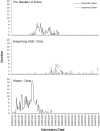COVID-19 in children across three Asian cosmopolitan regions
- PMID: 33138739
- PMCID: PMC7723019
- DOI: 10.1080/22221751.2020.1846462
COVID-19 in children across three Asian cosmopolitan regions
Abstract
ABSTRACT As another wave of COVID-19 outbreak has approached in July 2020, a larger scale COVID-19 pediatric Asian cohort summarizing the clinical observations is warranted. Children confirmed with COVID-19 infection from the Republic of Korea, the Hong Kong Special Administrative Region (HKSAR) and Wuhan, China, during their first waves of local outbreaks were included. Their clinical characteristics and the temporal sequences of the first waves of local paediatric outbreaks were compared. Four hundred and twenty three children with COVID-19 were analyzed. Wuhan had the earliest peak, followed by Korea and HKSAR. Compared with Korea and Wuhan, patients in HKSAR were significantly older (mean age: 12.9 vs. 10.8 vs. 6.6 years, p < 0.001, respectively) and had more imported cases (87.5% vs. 16.5% vs. 0%, p < 0.001, respectively). The imported cases were also older (13.4 vs. 7.6 years, p < 0.001). More cases in HKSAR were asymptomatic compared to Korea and Wuhan (45.5% vs. 22.0% vs. 20.9%, p < 0.001, respectively), and significantly more patients from Wuhan developed fever (40.6% vs. 29.7% vs. 21.6%, p=0.003, respectively). There were significantly less imported cases than domestic cases developing fever after adjusting for age and region of origin (p = 0.046). 5.4% to 10.8% of patients reported anosmia and ageusia. None developed pediatric multisystem inflammatory syndrome temporally associated with SARS-CoV-2 (PMIS-TS). In general, adolescents were more likely to be asymptomatic and less likely to develop fever, but required longer hospital stays. In conclusion, majority patients in this pediatric Asian cohort had a mild disease. None developed PIMS-TS. Their clinical characteristics were influenced by travel history and age.
Keywords: Asia; COVID-19; age-stratified; children; travel history.
Conflict of interest statement
No potential conflict of interest was reported by the author(s).
Figures
References
-
- WHO Coronavirus Disease (COVID-19) Dashboard ; [cited 2020 Sep 4]. Available from: https://covid19.who.int/
MeSH terms
LinkOut - more resources
Full Text Sources
Medical
Research Materials
Miscellaneous

